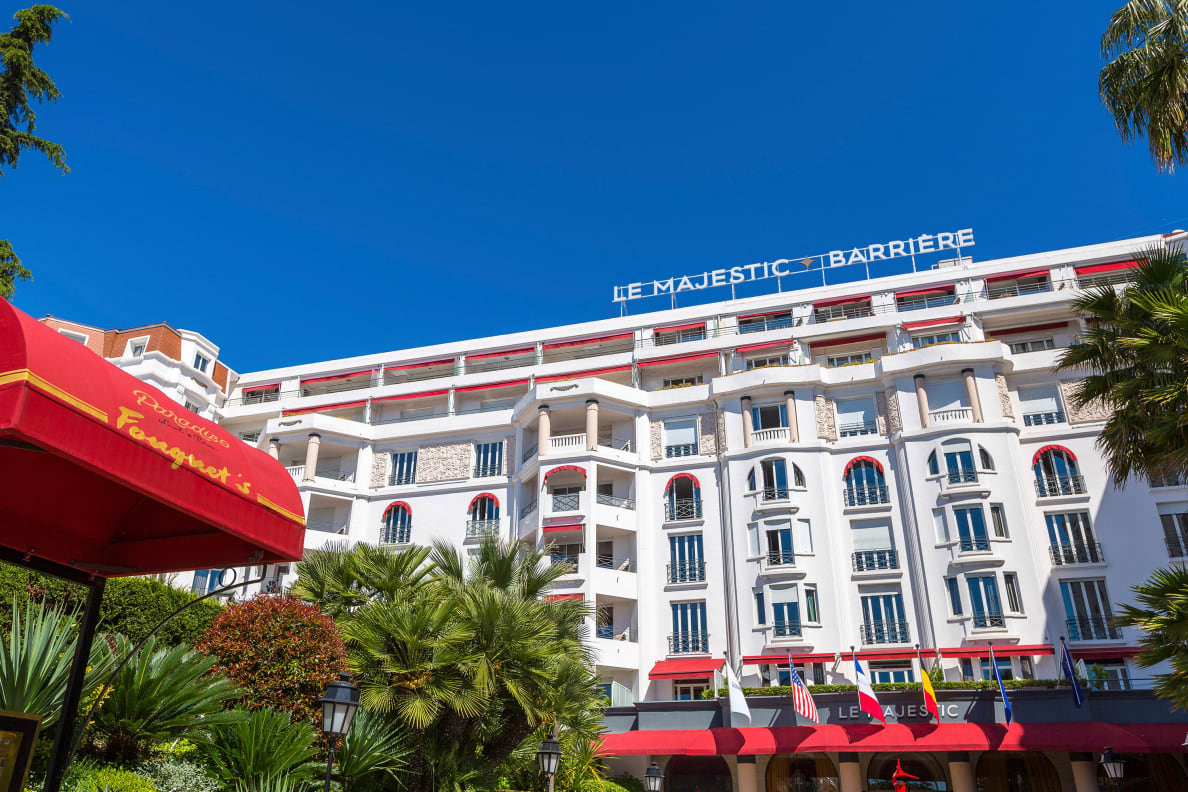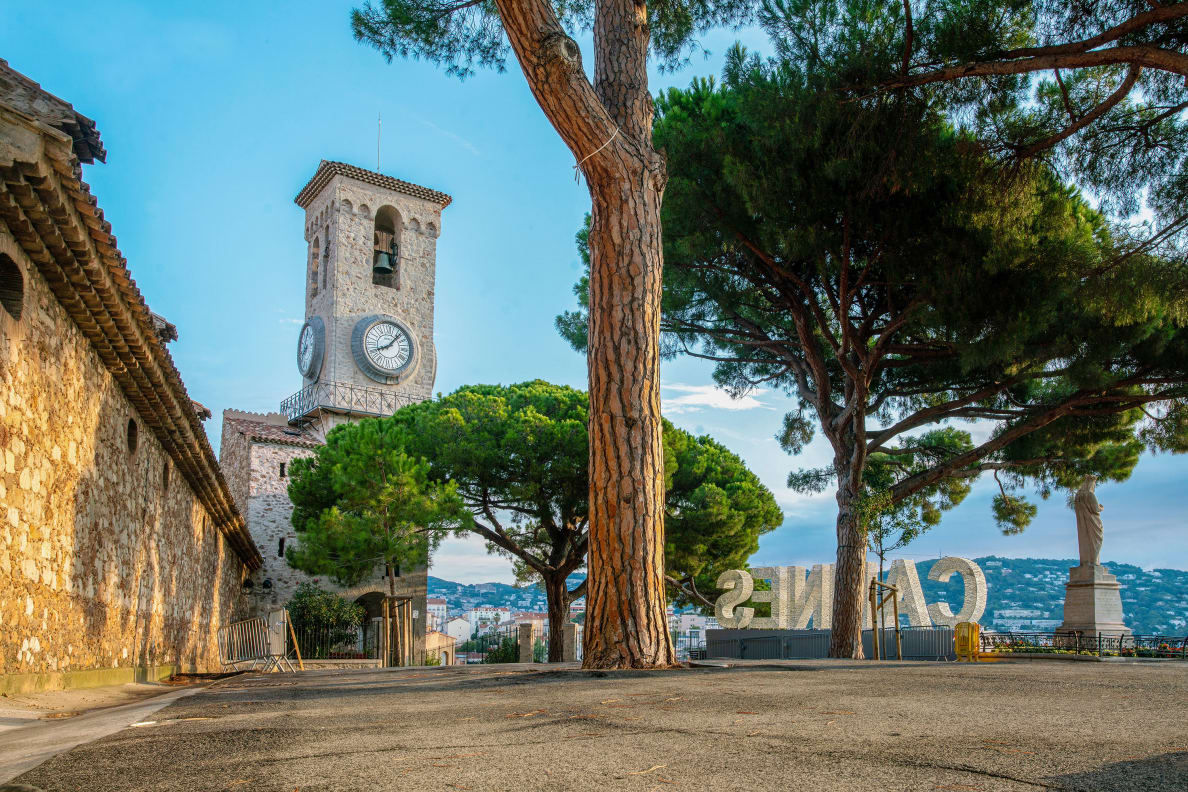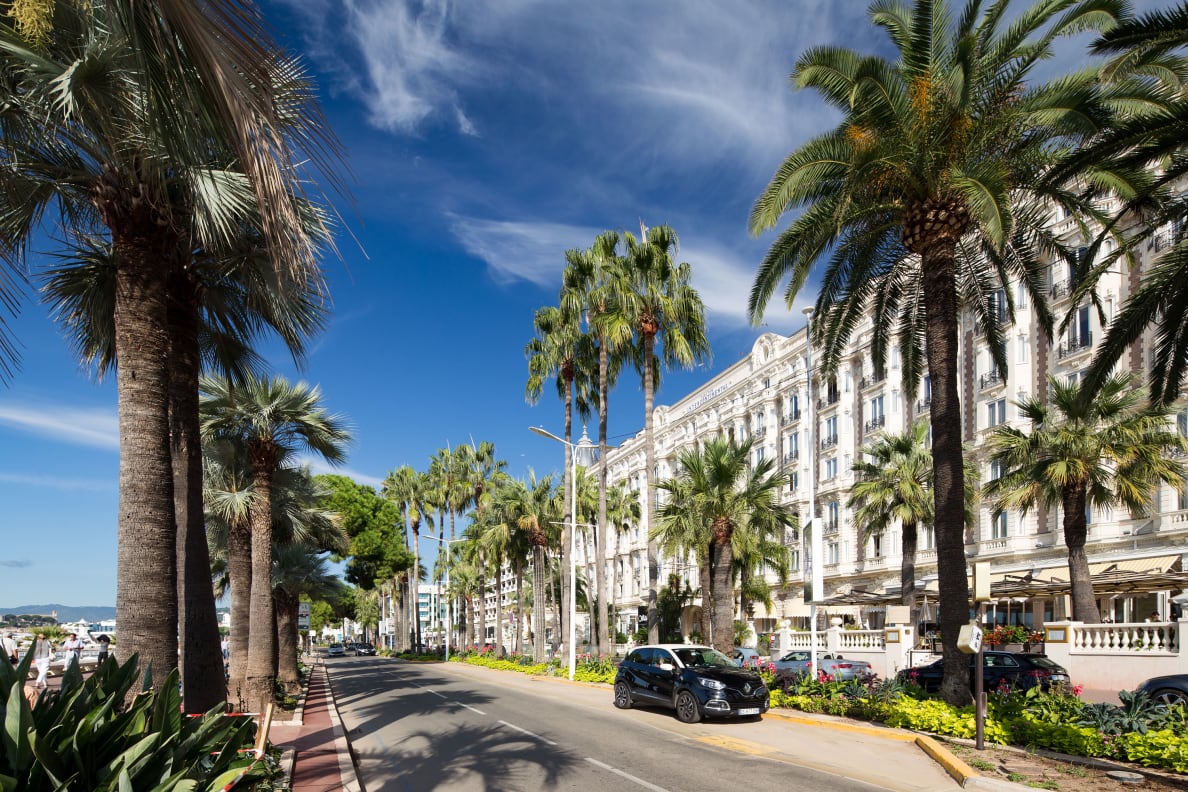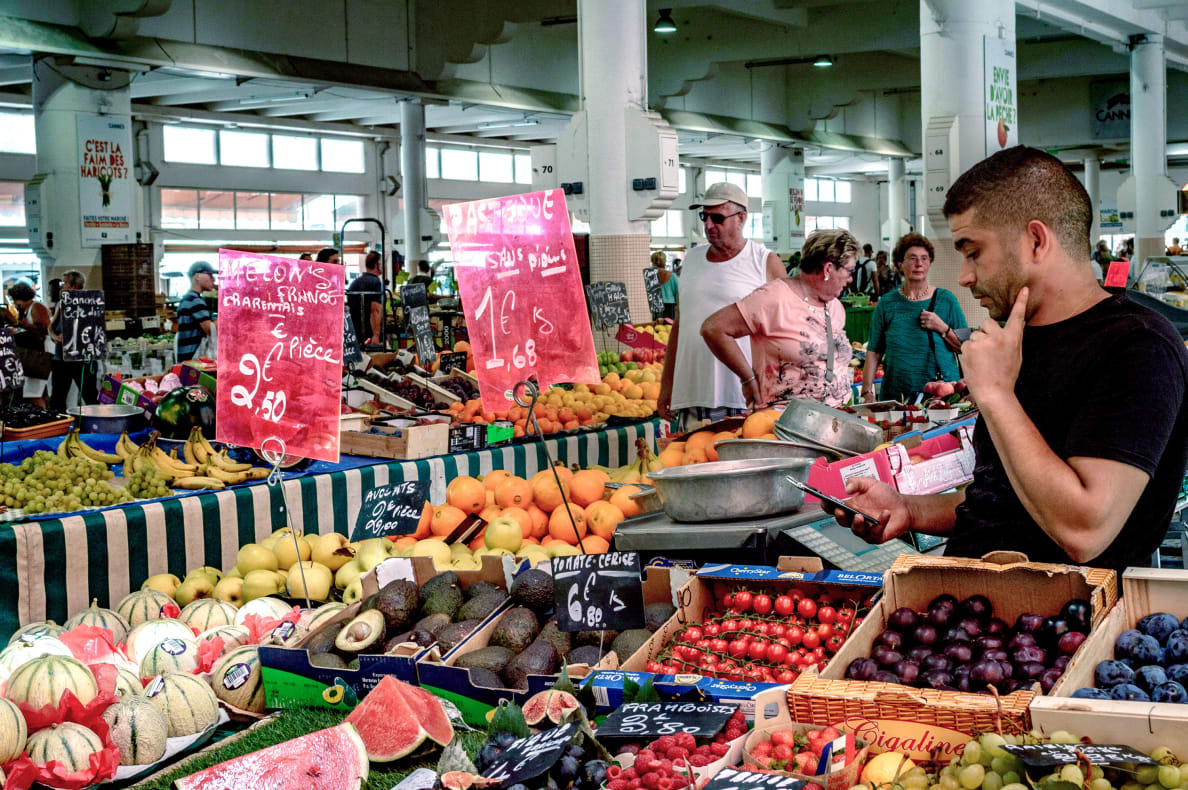Say the name “Cannes” and what likely comes to mind is a chaotic montage of paparazzi, glacier-sized bling, ostentatious superyachts, and entertainment royalty from Grace Kelly to Tom Cruise swanning around the fabled Croisette en route to a gala premier.
“…All about glamor and vulgarity,” the Danish director Nicolas Winding Refn quipped some years back while comparing The Neon Demon, his lurid and controversial cinematic fable about narcissism, to the city itself.
Indeed, although its iconic film festival debuted less than 80 years ago, the glitzy annual spectacle has since overshadowed Cannes to the extent that it’s easy to forget that this small seaside strip of France’s famed Côte d’Azur was ever anything other than a European epicenter for celebrity decadence.
When I arrived in the city during the first week of April, the storied promenade was clogged with cranes, workers, and power drills. Modular fencing papered with images of festivals past stretched down La Croisette, and numerous closed roads meant lots of detours and sluggish traffic that made driving even a short distance an hour-long mission. The star-studded annual event may have been weeks away, but it seemed there was no escaping its frenetic buzz. At first.

The exterior of Hotel Le Majestic.
Courtesy of Le Majestic
A closer look at Cannes during the shoulder season, however, reveals a softer, quieter city where you’ll find centuries worth of history, beautiful architecture, and simpler pleasures that prize tradition and authenticity over Hollywood flashiness. This laid-back side of one of Europe’s most famously glamourous locales, makes it perfect fit for our series on underrated destinations, It’s Still a Big World.
It would take several lengthy books (or a multi-season Netflix series) to begin to do justice to the city’s long and turbulent history, but what struck me the most while I was researching this piece is the contrast between its present-day prestige, and its humble (and extremely bloody) origins. First settled during the 2nd century B.C. by Ligurian tribesmen, the region that would later become Cannes began as a tiny fishing village. During the Roman Empire it was called Canois Castrum—a name that historians believe had origins in the “canna” (reeds) that once grew in the area.
Following the end of the Roman Empire, the city (now known as Canua) fell victim to numerous attacks and invasions, most famously by Saracen pirates. By the medieval era, monks controlled the region and built a hillside watchtower to protect the area from further aggressions. Even so, the next several centuries saw one bloody conflict after another, including the Four Years’ War that raged across Western Europe in the 16th century. Several decades after the end of the fighting, a plague outbreak in 1579 killed off more than half of the city’s residents.
A stroll through the Le Suquet neighborhood reveals vestiges of the city’s earlier days. Several blocks inland from the Croisette, the tangle of steep cobblestone streets, narrow alleyways, and cats lounging around on front steps reminded me of some of southern Tuscany’s hill towns. With a population of less than 75,000 people, Cannes too is more like a large town than a city. It just doesn’t feel that way when you’re shoulder-to-shoulder with throngs of fellow travelers. Indeed, a staggering three million visitors descend on the city every year—mostly during the festival and the summer season—giving it the dense feel and a hectic vibe that’s typical of larger locales.

Pine trees and the tower of church Eglise Notre Dame d’Esperance.
Fotofantastika
During this late afternoon in April, however, my walk yielded quiet streets, relaxed, candle-lit terraces, and scenes that were more quirky village rather than resort hotspot: A woman hoisting a bag of groceries up a steep alley flanked by walls the color of faded sorbet; an older man and his dog walking beside a high stone wall; a tall drag queen emerging from a café whose ensemble of vivid scarves, a billowing skirt, and large gold earrings evoked a love affair between a pirate ship and a gypsy caravan.
The neighborhood’s highest hill is crowned by two striking landmarks: Notre-Dame-d’Espérance, a stone church with a Romanesque bell tower, and the Musée des Explorations du Monde—the castle fortress that the monks built back in the Middle Ages. The fortress currently houses a museum with a hodgepodge of art and artifacts—everything from ancient string instruments to Himalayan masks—but it’s the sweeping view of the Bay of Cannes that warrants the hilltop trek. You can add a dose of cardio by taking on the 109 steps to the top of the tower where the views are even better.
The two centuries that followed the completion of the church brought yet more invasions (this time by the Spanish), but the city ultimately continued to expand and thrive. It was the 19th century, however, that marked a turning point for Cannes and saw it transform from a sleepy fishing town into an international resort hotspot.
In 1834, the Scottish politician and writer Lord Henry Brougham was en route to Italy when a cholera quarantine in Nice forced him to make a detour into neighboring Cannes. He was smitten with the place, ultimately constructing an Italianate villa up in the hills that he named after his daughter, Chateau Éléonore-Louise. The palatial structure still exists, but it has since been converted into upmarket apartments and is, alas, off-limits to visitors.
Other members of the British aristocracy took a cue from Brougham, and the once anonymous village morphed into a glamorous winter getaway for the European elite—many of whom also had lavish mansions built in or around the city. Some of these 19th-century beauties, like Brougham’s old digs, are private residences, but others have been given a second life as cultural spaces, such as Betty de Rothschild’s neoclassical villa, which has been converted into a media library that has (thankfully) retained its ornate Belle Epoque-era interior details.
The city’s magnificent Grand Hotel was replaced with a midcentury monstrosity in the ’60s, but its circa-1864 pavilion lives on in the form of a contemporary art museum that has exhibited works by legends like Picasso and Matisse, as well as by present-day artists. The space was sadly undergoing a revamp during my visit, but will reopen next year with the addition of a tea room with panoramic views.
Other architectural marvels are hiding in plain sight. A mens’ clothing store occupies a building with a shell-pink facade that’s embellished with iron balconies and intricate stone bas-reliefs of comedy and tragedy masks. A bit of digging revealed it was once a late 19th-century theater. You can find it on rue d’Antibes—the city’s main shopping artery. Luxury chain stores and myriad luxury eyewear boutiques are the street’s main tenants, but it’s worth a stroll for the people-watching alone.
There are also a few local standouts, including Taizo—a tiny jewel box of a store that’s been around since the ’90s and specializes in hard-to-find luxury fragrance brands like Frédéric Malle and House of Sillage. Bathroom Graffiti is a few doors down and has also been open for several decades. Best described as a concept store before there were concept stores, it’s filled with offbeat gifts and random ephemera, including a giant golden gorilla, day-glo garden gnomes making vulgar gestures, and mini-biographies of icons like David Bowie and Coco Chanel written for kids.
The Croisette runs parallel to rue des Antibes and was constructed in the late-1800s, when development continued to flourish. The early part of the next century saw the arrival of luxury seaside hotels like the Carlton, Le Majestic, and the Hôtel Martinez that line the famed promenade like angular wedding cakes.

Boulevard de la Croisette, constituting Canne’s glamorous waterfront is filled with luxury boutiques and upmarket hotels.
Pawel Toczynski
One of these legendary lodgings, the Hôtel Barrière Le Majestic, (still known locally as Le Majestic) served as my home during my stay. The beachfront property overlooks the Palais des Festivals et des Congrès where the festival is held, and is a longtime favorite of cinema executives and celebrities. The hotel debuted in 1926, and this self-described aficionado of all things Jazz Age was smitten with its meringue-white Art Deco facade and red awnings.
The Majestic is booked solid during the festival when the film world fills its ocean-front suites and private beach, but when I arrived the sky was overcast (so much for Riviera sunshine) and the hotel was devoid of high-season crowds. I feasted on scallops with truffle cream sauce at their seaside Mademoiselle Gray restaurant, which sits on a private beach and turns out surf-and-turf dishes with a Mediterranean influence set to electro ambient beats, giving it a swanky beach cabana vibe. It was their pillowy pain perdu (French toast), however, with its delicate melange of lemon, olive oil, and caramel that has me fantasizing about a return trip and wondering if I can bribe the chef to hand over the recipe.
The thinner crowds also meant that the hotel’s signature suites were vacant, which allowed me to take a peek at where festival honchos hunker down. Think bathrooms that rival the size of some Paris studios, in-room aromatherapy machines, and sprawling terraces with views of the Mediterranean. The seventh-floor penthouse suite has a sprawling 4,800 square feet of space, and houses a gym and a movie theater. A heated rooftop pool looks out over the sea—a perfect setting, I thought, for next-level debauchery. The nightly rate isn’t listed on the hotel’s website, but a French architecture magazine recently listed it at €30,000 ($33,380) in case you’re interested.

All this copious luxury was impressive, but more intriguing was what goes on behind the scenes, which is centered on the city’s simpler riches. Forville, a covered market hall that debuted in the late 1920s, is where chef Pierrick Cizeron stops every morning for seasonal produce and local cheeses that he uses in many of his recipes. A few blocks inland from the Old Port and an easy walk from the hotel, the market hall, while certainly not unknown to tourists, is also a favorite of cannois who live in the neighborhood. Strawberries and asparagus were both coming into season, and I wish the berries—deep red and nearly the size of crabapples—traveled better.
Back at the hotel, the ingredients in Bar Foquet’s cocktails are grown onsite. The bar is helmed by Emanuele Balestra, who’s something of a celebrity in the beverages world and creates inventive drinks via a process that combines horticulture with chemistry. Purple basil, bergamot, and rose geranium are among the various plants he uses in his concoctions, and a hidden rooftop garden is where most of them are cultivated. The plants and herbs are then dried before undergoing an extraction process in a laboratory equipped with high-tech ultrasound equipment. The resulting plant essences and aromatic ”edible perfumes” are then used in his inventive elixirs.
Hard alcohol isn’t typically my thing, but the champagne and gin cocktail he made me could make me change my mind. Infused with flowers and plants, including mimosa and centifolia with several drops of lemon verbena bitters, the resulting elixir was less a drink and more a sensory experience. Wonderfully smooth and not at all syrupy, the blend of flower essences complemented both the booze and each other, and a spritz of verbena perfume on the glass amplified the taste.
My drink was served in a champagne flute, but the lowball glasses nearby—some with a slight tilt, others with rims that cave inwards like melted wax—caught my eye. The latter’s surreal shape was created to better capture the aroma’s of Balestra’s creations and (sigh) aren’t for sale, but it’s possible to visit the factory where Balestra had them custom-designed. A tiny village of less than 10,000 inhabitants, Biot is about a 20-minute drive from Cannes and is considered France’s glass capital. The factory opened in 1956 and became the first in the region to allow the public to enter and watch the glass-blowing process.
“People were afraid of competitors stealing their secrets,” the owner, Serge Lechaczynski, explained as we watched several workers unload wand after wand topped with orange globes of molten glass out of the factory’s furnaces. The end result is colorful vases, champagne flutes, and other glassware embedded with tiny bubbles that look like carbonated water in suspended animation. The style has long been popular in the region, and apart from furnace upgrades so that less heat is expelled, the facility and its traditional glass-blowing methods, hasn’t changed much since the ‘50s.
On my last day in Cannes, I hopped a ferry to Île Saint-Honorat—one of two small islands just off the city’s coast. Monks have inhabited it since the fifth century, save for several violent interludes, including during the Saracen raids when many of them were murdered, and in 1635 when the Spanish invaded and captured the island. During the French Revolution, the state seized Île Saint-Honorat, forcing its religious community into exile in nearby Vallauris.

Abbey of Lerins on the island of Isle St Honorat off the coast of Cannes in Cote d’Azur, French Riviera
Smartshots International
The island experienced a brief brush with mainland-style decadence after the French government sold it to Mademoiselle de Saint-Val, a successful and wealthy actress who was also the mistress of Jean-Honoré Fragonard—the celebrated Rococo painter known for his erotic oeuvres. De Saint-Val occupied the island’s monastery for two decades, during which she renovated it to her tastes, including, rumor has it, the addition of artwork with hedonistic, rather than religious themes.
Ironically, it was during the mid-19th century, when opulent mansions were cropping up on the mainland and wealthy socialites were arriving in droves that the island returned it to its religious roots. The Bishop of Fréjus purchased the land in 1859, and a decade later when Europe was on the brink of moving into its lavish Belle Époque period, an order of Cistercian monks was established on the island that has been here ever since.
The boat ride over only takes about 15 minutes, but the contrast between the busy mainland and the deserted rocky beaches and small footpaths lined with pine trees evoked a far more remote destination. On the morning of my visit the sun had finally appeared, casting Impressionist-style splotches of light on the walking paths and illuminating the exterior of the 19th-century Lérins Abbey. Clusters of grape-sized wisteria blooms dangled around the garden like errant purple fountains, and the only sound came from an occasional plane passing overhead.
Less than a mile long, the island is dotted with vineyards and olive groves that the current brotherhood of 20 monks tend to year-round. Along with several organic wines, they also produce plant and fruit-based liqueurs, including Lérina Verte—a strong, citrine-green libation that’s composed of 44 different plants and tastes a bit like sweet mint leaves dipped in fire.
While I was admiring the wisteria, I crossed paths with Jean Vial, who was staying at the abbey on a weeklong retreat and offered to accompany me on a guided stroll around the island. An energetic septuagenarian who looks younger than his years, Vial, who lives in the region, told me he has been taking annual retreats here for the past five years. The pre-dawn wakeup time didn’t bother him, he said, and every day he made a loop around the entire island at least twice. He said that the wooded paths, sea views, and simple rhythms of life at the monastery have a soothing effect on his body and mind and provide a yearly reset of sorts.
First we passed was the island’s medieval fortified monastery, which seems to rise out of the sea like a geometric ship run aground.
“They were soldier monks,” Vial said, in reference to the Middle Ages-era religious community that built the imposing structure to guard against the long stream of invaders.
During our walk he pointed out other landmarks, like a World War II-era bunker and the stone munitions ovens used to heat cannonballs during the Napoleonic wars. At one small inlet he showed me a deserted beach with a natural swimming pool bordered by a necklace of large, smooth rocks where he and his friends would spend summer afternoons during his younger days. A step ladder had been carved into the side of one of the rocks and just beyond was the agate plank of open sea.
The view is probably quite different in July with the thousands of tourist boats plying the water and the crowds of swimmers converging on the small coves. But in the early spring sunlight, the gloriously vacant stretch of seashore appeared to embody the wild beauty of Cannes that had everyone from pirate invaders to British lords to pre-revolutionary stage actresses wanting to claim a piece of it.
“There’s no one here,” Vial said, seemingly echoing my thoughts as he gestured to the empty beach.
“That,” he added, “is true luxury.”
